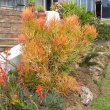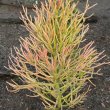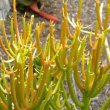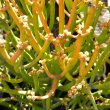| Botanical Name |
Euphorbia tirucalli - cultivar Rosea |
| Family |
Euphorbiaceae - The euphorbia family. |
| Pronunciation |
yoo-FOR-bee-uh tee-roo-KAL-ee 'ros-EE-a' |
| Common Name(s) |
English: Firesticks; Sticks on fire
|
| Plant Group |
- Shrub A woody plant of relatively low height, having several stems arising from the base and lacking a single trunk; a bush.
|
| Plant Size |
- Medium to Large
| Tree | 15m to 20m |
| Shrub | 2m to 3m |
| Perennial/ground cover | 60cm to 75cm |
| Bulb | 60cm to 1m |
| Succulent | 60cm to 1m |
- Small
| Tree | 4m to 8m |
| Shrub | 50cm to 75cm |
| Perennial/ground cover | 10cm to 20cm |
| Bulb | 20cm to 30cm |
| Succulent | 10cm to 20cm |
|
| Position |
- Sun The area is in full sun for all or most of the day, all year round.
|
| General Information |
- Drought Tolerance: High The plant is well adapted to arid conditions; it can survive long periods of drought and high temperatures without extra water.
- Evergreen Plants that have leaves all year round.
- Frost: Tender A plant that will not survive any frost or low winter temperatures.
- Water Wise Plant species originating from low rainfall regions that require less water to survive and thrive than other plant species.
- Wind Tolerant Plants able to withstand the effect of strong winds.
|
| Specific Information |
In the Albany area I have noticed that this cultivar seldom grows more than two meters in height, making it an ideal feature plant for the rock or pond garden.
NOTE: The latex is very toxic and may cause blindness, blisters on the skin, and death if enough of it is swallowed.
|
| Ad Break |
|
| Flowers |
| Description |
|
| Season |
- Spring to Summer Plants will seldom bloom for the entire season as given in the list, but should flower during a period within these parameters.
|
| Colour |
|
| Growth Rate |
- Moderate Specifying growth rate can be very misleading as there is considerable variation of growth rate depending on type and species of plant, available water, supplementary feeding, mulching and general care, as well as the plants suitability and adaptability to the garden environment.
|
| Plant Uses |
- Attracts bees, butterflies or other insects This plant attracts insects which can be food for birds or other creatures in your garden.
- Attracts Birds This plant will attract birds.
- Boundary A plant useful for planting around the edges of the property to form a green or colourful backdrop, an impenetrable hedge, to hide walls or create privacy.
- Container Trees, shrubs and ornamental species that can adapt to growing in a restricted environment.
- Filler Either a fast growing tree or shrub used temporarily to fill in an area while the permanent plants grow to a desired size, or a plant used to fill gaps in borders or beds.
- Foliage Plant Plants grown because their foliage is colorful or unique. Many of these plants have insignificant flowers.
- Hedge Suitable trees or shrubs planted relatively close together so that the branches intertwine to create a barrier. This can be formal – the plants are regularly trimmed to produce a neat shape, or informal – the plants are left to themselves to create a natural hedgerow.
- Pioneer for new gardens A very fast growing plant, able to withstand hardship, that can be used to populate land that has recently been cleared of natural vegetation. These plants pave the way for slower-growing species by adding nutrients to the soil and creating leaf litter.
- Rock Garden An area constructed of larger rocks, arranged naturally, to emphasise the use of stones as a main element. Generally plants used do not need a lot of care.
- Screen A tall hedge of suitable plants planted closely together and used as a windbreak, to block a bad view, to separate parts of the garden or as a backdrop.
- Suitable for coastal gardens Plants adapted to dry, sandy soil, forceful wind, limited rainfall and intense sunlight.
- Wild Garden An indigenous garden planted for the benefit of wildlife and birds. Provides food, water, a variety of mini-biomes and no poisonous chemicals are used.
- Windbreak Trees planted in a row to form protection from prevailing winds by breaking the force of the wind, thereby reducing wind damage.
|
| Distribution and Habitat |
|
| Planting Suggestions |
Plant in a mixture of garden soil and a little compost if the soil is very depleted - if you spoil it too much the branches will grow lanky. Mulch to retain moisture, and don't over-water. Good drainage and a dry, hot environment bring out the lovely colours of this ornamental plant. It will stand pruning to keep it in shape but do wear gloves and be careful of the drops of latex that pour out. Apart from its toxicity, I have found that the latex is difficult to get off the skin. Despite this bad press, the all year colour and its wind and drought tolerance can be replaced by few other plants.
|
| Medicinal Uses |
|
| Ad Break |
|








Comments
I saw this plant (Euphobia
I saw this plant (Euphobia tirucalli)is used for broken limbs of cattle. I have seen a person using it in South India.
Euphorbia tirucalli
Hi Umesh
Thanks for your interesting comment. The plant must have been introduced to India as my research only mentions it growing naturally in Africa. I would like to know how it was used. Perhaps you could give me some more information?
Kind regards
Lorraine
Firebush
Hi Lorraine.
I find your site extremely informative, thank you.
Can I cut of pieces of this plant and replant? What would be the best way to do this?
Propagating Firesticks from cuttings
Hi Isabel
This species is very easy to grow from cuttings. I have found it best to just break off the branchlets that I want to use, rather than cutting them, so that I get a 'heel' on the end of the stem. Thicker stems will need to be cleanly cut. I look for well-shaped stems with a neat, bushy head, snap the lower stems off if necessary, to clear the lower part of the stem, and leave them in the shade for two or three days to allow the ends to dry thoroughly. After that they can be planted in well drained soil directly into the garden or in pots. Keep soil just moist - never soggy. It takes quite a while before the cuttings root. Remember to avoid getting the sap on your skin or clothes.
The pic on the left shows poorly chosen cuttings, while those on the right show well-shaped cuttings. The cuttings on the right were forgotten and have been out of the ground for six weeks!
Kind regards
Lorraine
Stunt growth?
I planted my succulent/cactus garden last year. Mulched with lava rock. All other plants are doing great but my sticks on fire just sit there. There's practically no growth. Not dead just not growing.There is an opuntia and an aloe right next to it and they've almost doubled in size. I have a couple of golden barrels nearby, echeverias happily bloom...so there's nothing wrong with soil or sun exposure (I live in California). Does it need more or less water than a typical succulent? Fertilizer? I'm afraid it will disappear in the landscape soon...thanks!
Poor growth of Euphorbia tirucalli
Hi Natasha
I have seen this happen to this cultivar before, where the plants are used in the incorrect environment. As you say, they don't die but they don't grow. There are a number of reasons why your plant is not thriving.
First of all, it is not a 'desert' plant as such, when compared to the other plants you have mentioned. The natural habitat of Euphorbia tirucalli is a dryish forest environment with reasonably good soil, occasional light shade from surrounding plants and plenty of organic mulch.
The variety 'Sticks on Fire' is a cultivar, making it even less tolerant of poor conditions than the plant from which it was originally developed.
A mulch of lava rock keeps the soil warm, but this can be a problem when the hot summer sun warms the rocks to high levels, harming plant's roots with excessive heat. As the rocks cool overnight, moisture evaporates from the surrounding soil creating an even drier environment for the plant. Furthermore, lava rock provides no nutrients to the soil, resulting in an essentially barren environment for this plant.
Adding fertilizer will not help matters much as the other negative factors that are present will over-ride any benefits that could be derived.
You have two possible options here. Ideally, move the plant to a position that is more favourable and mulch with organic material which will add nutrients to the soil, retain water and keep the roots cool, or you could dig a large, deep hole in the succulent bed, fill it with good garden soil, replace the plant, mulch with organic matter and provide more water than you would for the other plants in the area. The second option would give the plant a temporary boost but may not provide a long term solution.
The growth rate of this cultivar is moderate at best, so it really needs a more nurturing habitat.
Kind regards
Lorraine
Fire stick cuttings
Hi
Would anyone send me a cutting in Brazil?
All the best,
Laerte
Sending plants overseas
Hi Laerte
It is illegal to send Indigenous plants out of the South Africa without the necessary permits and clearances. You are more likely to find a supplier in the USA, where there are a number of sites that sell plants on line.
Kind regards
Lorraine
getting cuttings
Where can I get cuttings by mail?
Hi Laerte
Hi Laerte
Google: 'Euphorbia tirucalli buy online'
Kind regards
Lorraine
Euphorbia tirucalli
Thanks a lot.
PET FRIENDLY
Hi Lorraine
i have just bought 3 fire sticks to plant in a section of my garden that my dogs have constant access to. i am a bit perturbed about the "poison"- if they run into the plants and they break off will they be affected by the poison sap?
Euphorbia tirucalli - Possible harm to dogs
Hi Allison
I can't see that you would have a problem. The stems don't break off too easily and only a few drops will dribble out, by which time the dogs will be long gone. The only dangers I can foresee is that if one of them were to get a drop of sap in the eye or if a dog were to chew on or eat the sticks - events that are both highly unlikely and which I have never come across. A drop or two of sap landing on fur may be tacky and difficult to remove but will not harm the animals.
Kind regards
Lorraine
Discuss this plant
Share knowledge, ask a question or give an experience.